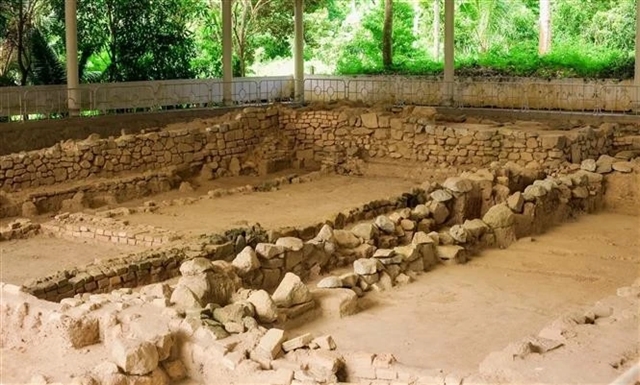The ancient Óc Eo Civilisation flourished in southern Việt Nam from the 1st to the 7th century.

An excavation site of the Óc Eo - Ba Thê special national relic site in An Giang province. VNA/VNS Photo
AN GIANG — The Mekong Delta province of An Giang aims to complete a nomination dossier next year to seek UNESCO recognition for the Óc Eo - Ba Thê archaeological site as world cultural heritage, a local official has said.
Nguyễn Hữu Giềng, Director of the Óc Eo - Ba Thê Cultural Relic Site Management Board, made the statement at a conference held on April 21 to discuss the preparation of the dossier.
The special national relic, representing the ancient Óc Eo Civilisation, spans 433.1 hectares in Óc Eo town of Thoại Sơn District. The civilisation, which flourished in southern Việt Nam from the 1st to the 7th century, was first discovered in 1942 by French archaeologist Louis Malleret through artefacts unearthed in the Ba Thê Mountain area, now part of Óc Eo town.
Currently, An Giang is home to more than 80 Óc Eo relic sites. Among them, Óc Eo - Ba Thê stands out as a key location. Once a bustling urban centre, port city, and major economic and cultural hub of the ancient kingdom of Phù Nam, it was recognised a special national relic site in 2012.
In October 2021, the Prime Minister approved the submission of a brief report to UNESCO, proposing the site for inclusion in the tentative list of world heritage sites.
Nguyễn Khắc Nguyện, Deputy Director of the management board, noted that with support from the Ministry of Culture, Sports and Tourism, the Việt Nam National Commission for UNESCO, the National Cultural Heritage Council, and the Việt Nam Academy of Social Sciences, the brief report was completed on April 1, 2022. UNESCO has agreed to include the site in its tentative list.
In late 2022, the An Giang provincial People’s Committee issued a plan for developing the full nomination dossier. However, due to certain challenges during the appraisal process, the detailed plan and budget were only approved in late 2024.
At the conference, it was announced that a consortium—comprising the Institute for Conservation of Monuments, the Centre for Geological, Heritage, and Environmental Applications Research, and the University of Social Sciences and Humanities in HCM City, had won the contract to compile the nomination dossier and management plan for the site.
Trần Thị Minh Huệ, Deputy Director of the Institute for Conservation of Monuments, said the work will be carried out from April 2025 through January 2026.
Focus will be on conducting research, survey, and systematisation of documents and artefacts to identify the site's nature and heritage value. This includes archaeological excavations, mapping the site, creating distribution diagrams of the relics, and analysing material samples and metal compositions of structures and artifacts.
The institute will collaborate with relevant agencies to develop thematic studies that demonstrate the site's outstanding universal value, integrity, and authenticity, Huệ added. VNA/VNS